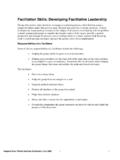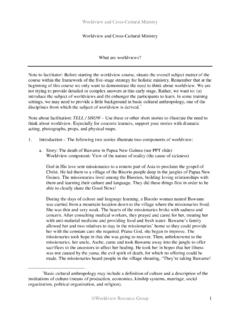Transcription of Tips for Effective Facilitation - A2Zproject.org
1 tips for Effective FacilitationUSAIDFROM THE AMERICAN PEOPLE UNITED STATES AGENCYINTERNATIONAL DEVELOPMENTUSAIDThis training module is made possible by the generous support of the American people through the United States Agency for International Development (USAID) under the terms of Cooperative Agreement No. GHS-A-00-05-00012-00. The contents are the responsibility of the Academy for Educational Development and do not necessarily reflect the view of USAID or the United States of this training guide can be obtained from:A2Z: The USAID Micronutrient and Child Blindness ProjectAED1825 Connecticut Ave, NWWashington DC, more information, please contact:Nadra FranklinProject Director, A2Z1825 Connecticut Ave, NWWashington DC, 2011 tips for Effective Facilitation3 tips for Effective FacilitationTips for Effective FacilitationAs a facilitator, you will have to work with the groups and play an important role in facilitating an understanding of the Child Anemia Training Module and the implementation of the strategy at the SHC level.
2 This part of the toolkit is designed specifically to give you tips on facilitating the tension: One of the best ways to do this is take deep breaths. Breathe from your diaphragm and remember to exhale all the way. It also helps to exercise regularly, as unused energy may come out as anxiety. Rehearse: After you have mastered the material, practice the presentation until you feel confident. Before giving the presentation, visualize yourself succeeding. If you imagine success, you are more likely to be successful. Know the room and your equipment: Finish testing your audio-visual equipment and complete set-up before participants arrive. The training module includes a section on preperation. You must read this and prepare for your session accordingly whether it is in preparing photocopies, putting up chart papers, or getting equipment the participants: Talk to them as they arrive it is easier to speak in front of people you are familiar with than a group of strangers.
3 Reassure yourself: The participants are not there to see you perform; they are there to learn the material. People are not scrutinizing you or waiting for you to make a mistake. Most likely, they want you to succeed and facilitate an interesting session. Re-frame: Feeling nervous and feeling excited are very similar. Harness your nervous energy and turn it into enthusiasm. Resist imitating another s style: Be natural and relaxed. Only use others techniques if you can do it without thinking. Concentrating on presenting like someone else takes your focus away from the material, possibly creating anxiety. Know your first line and the transition to the main point: Memorizing the introduction to the session can dissipate anxiety and help you begin with confidence. Concentrate on the message, not yourself: Try as hard as possible to turn your attention outward.
4 Focus on what you are there to do. Engage the participants in the material so they can learn effectively. Rest and eat well: A session requires a lot of energy, enthusiasm, and focus. Being on your toes for several hours can be mentally and emotionally exhausting, so get plenty of rest and nutrition so that you are physically and psychologically alert. 4 tips for Effective FacilitationFacilitating Discussion Actively engaged participants are more likely to recall and use the information outside of the confines of the session. However, leading an active session is hard and requires solid Facilitation skills. For this reason, the following sections cover some key Facilitation skills that you will need to effectively lead an active and productive session. This section reviews guidelines needed for: Leading vs.
5 Directing The key to facilitating effectively is to remember that your role is to lead the discussion, not direct it. As a leader, you should focus on drawing ideas out of the participants, rather than dominating with your ideas and experiences. The following are the tips to help you remember to facilitate rather than direct: Respect the participants: Demonstrate this respect by calling them by their titles and listening actively. Be enthusiastic about the topic and the session program: Display your enthusiasm by leaning towards participants when they are speaking. Ask and encourage questions and idea sharing: Do not use negative language, such as, That s wrong, when responding. Be clear and direct: This means give examples and avoid the passive voice, such as, Health inequities are revealed by the data, instead of The data reveals health inequities.
6 Keep your own contributions during group discussions brief: Let participants respond to questions and to one another first. If they answer a question completely, you need not add additional information. Most of the debriefings will work like that. However, it is important for you to consolidate the session s topics, so participants can easily discuss and learn from each other. Use silence to give participants time to think about an answer or response to a question before you give them the answers. : Count to 10. If you don t get any responses from the participants, re-phrase the question and count to 10 again. Then, prompt the group with an answer and ask for others. Encourage the participation of people who have been quiet: One way to do this is to state the participant s name first and ask the participant an opinion question with no correct answer.
7 You can avoid putting the participant on the spot by asking a question you know she or he can easily respond to. Facilitating Discussion Discussions effectively promote active learning. However, interesting discussions that engage the group rarely develop by chance. This section offers tips in the following areas to help you stimulate interesting discussions: Asking Questions 5 tips for Effective Facilitation Responding to Incorrect Answers Answering Questions This section can also be used by the trainer in facilitating the session on counseling that will emerge from the role plays. The facilitator can also give tips on counseling and asking questions to the mothers and caretakers using this section. For example, the tips talk about using open-ended questions that encourage answers beyond yes or no and asking sensitive questions without hurting the sentiments of Questions It is the responsibility of the trainers to pose stimulating and intriguing questions or topics for discussion.
8 Below are some tips for asking questions that yield powerful responses. Use open-ended questions that encourage answers beyond yes or no. Example: Closed question: Did you like the session? Open-ended question: What did you like about the session? Ask honest and relevant questions- Begin by engaging participants around what they know. This will certainly help you in elicit responses about challenges that they face in the field,Use think back questions- When trying to engage participants in a discussion about their experiences, ask them to remember their past instead of imagining a hypothetical situation. This will be particularly helpful when you are discussing possible solutions to the challenges that they clear and concise questions- Make sure your questions cover only one issue at a time.
9 Use unbiased questions- Phrase questions in a way that does not betray your opinion and that does not guide the participants to answer one way or another. HINT: If no one is responding to your questions, remember to try and ask it in a different way. If that does not work, try prompting the group with an answer. Avoid asking why. When asked why they think something or feel a certain way, people can become defensive for many reasons; they might not have an answer, they might not want to share their answer, or they might feel as though they do not need to justify what they believe. Instead of asking someone why they believe something, try asking them what experiences led them to that conclusion, to give examples, or other strategies that will help draw out more information. 6 tips for Effective FacilitationDescription Example Introductory: To begin talking about the session topic, ask broad questions.
10 How would you describe a responsive service delivery system at the Zilla and Block levels? Transition to move the discussion on to the key questions. Think back to Session III where we have spoken about the causes of anemia. For children, what are the causes according to that discussion?Key to get detailed information on the central topic of the session. What needs to be done to make sure that all pregnant mothers register for antenatal care (ANC) and take iron and folic acid (IFA) tablets for at least 100 days? Is there anything else anyone would like to add before we move on? Summarize the discussion at the end. Next we will talk about what each of us can do to encourage families for ensuring that each child is given the full iron supplement. Responding to Incorrect Answers Do not shut down a person who gave an incorrect response.






